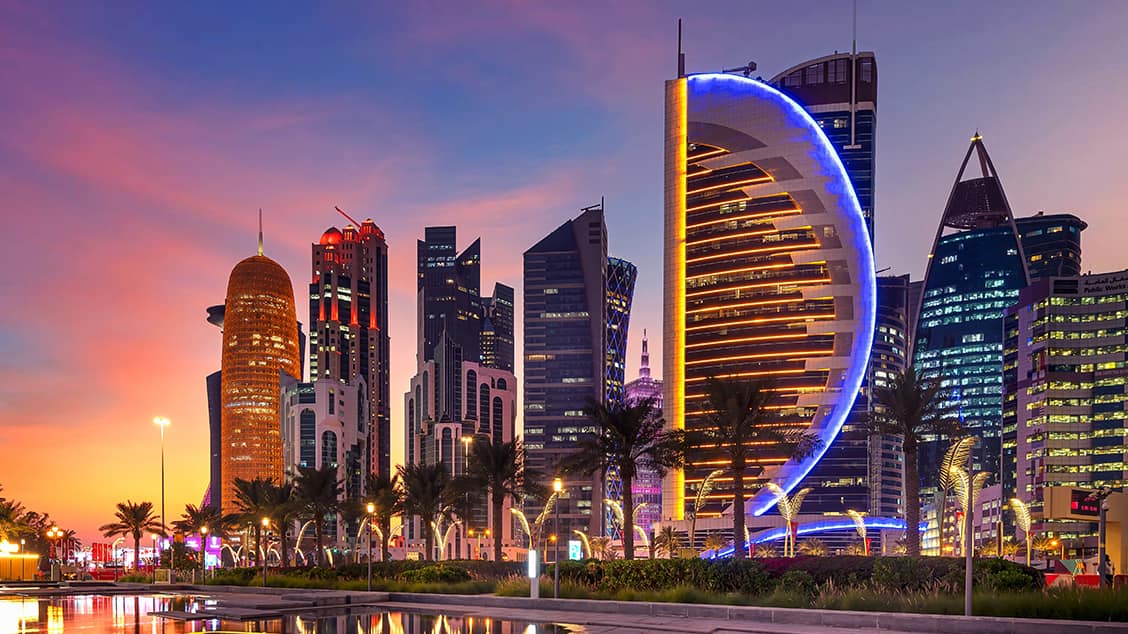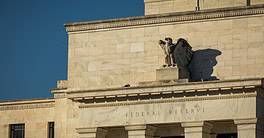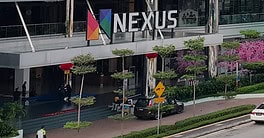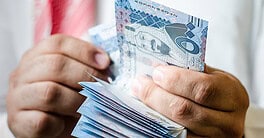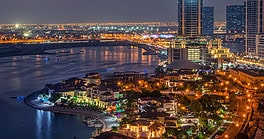Qatar is rich and getting richer. The tiny Persian Gulf state boasts a per capita GDP that is one of the highest in the world, topping $77,000, and its economy should grow a modest but steady 2.4% this year and 2.2% in 2024, according to the International Monetary Fund.
While in most parts of the world energy prices have become a source of daily anxiety and a public policy struggle, in Qatar it’s quite the contrary. Despite the initial pessimism for the world economic outlook at the beginning of 2023, growth forecasts gradually improved throughout the year. Energy prices, as usual, claim the credit.
“In the Gulf Cooperation Council, countries continued to benefit from elevated oil and gas prices, driven by the post-pandemic recovery, geopolitical conflicts, and OPEC production cuts,” says Adel Khashabi, senior executive vice president of QNB Group Asset and Wealth Management. “This further improved the already positive macro environment for the State of Qatar.” QNB Group is the MENA region’s largest lender by assets, with $365 billion; it recorded 8% growth in net profit during the first nine months of 2023. Loans and deposits also increased by 7% and 4% from the previous year the bank reports.
Qatar sits on the world’s third-largest natural gas reserves, and hydrocarbons account for 90% of its exports and 80% of revenue. From Doha’s perspective, the equation is simple: sell more fuel, make more money. By 2027, the authorities expect their North Field Expansion plan (NFE) to vault liquified natural gas production from 77 million tons per year currently to 126 million.
“Qatar continues to be one of the world’s largest LNG exporters,” says Joseph Abraham, CEO of Commercial Bank of Qatar. “Economic activity should continue to be supported by investment related to the North Field gas expansion and robust growth in logistics, manufacturing and trade.”
Last year, the bidding process for the North Field attracted oil majors from all over the world; QatarEnergy, the state’s public petroleum company, signed agreements with China National Petroleum Corp, Sinopec, Shell, TotalEnergies, ConocoPhilips and ENI.
“The NFE is one of the largest capital expenditure projects regionally and industrial projects globally,” notes Khashabi, who foresees huge growth potential for corporate banking as well. “The project will include an equivalent expansion of Qatar’s refining, downstream, petrochemical, and fertilizer capacity. Positive spillovers from these projects will combine with diversification efforts and structural reforms to boost economic activity and spending in the broader manufacturing and services sectors.”
Selling all that extra gas should not be a problem. Asian countries looking to break away from coal are already big LNG buyers, and so is Europe as it combs the world for alternatives to Russian energy supplies. In the years to come, LNG is widely expected to remain in high demand as a component of the energy transition, doubling to reach 700 million tons a year by 2040. By that time, QatarEnergy hopes to be the world’s largest LNG trader, beating Shell.
A Strong Financial Sector
In just a few decades, Qatar transformed from a small desert state to one of the world’s richest nations; to manage all that wealth, it built up strong financial institutions.
“Despite the global economic challenges, Qatar’s financial sector has maintained its competitiveness and profitability,” says Abraham, bolstered by “a robust regulatory framework, strong capitalization, and prudent risk management practices.” Ongoing investments in infrastructure projects, diversification efforts, and Qatar’s status as a regional hub “have further supported the sector’s performance.”
In a recent report, global consultant PwC found Qatari banks’ growing assets, loans, deposits, income, and profits reflect “high adaptability to the changing interest rate environment.” The Qatari riyal is pegged to the US dollar and the state’s monetary policy moves in sync with the US Federal Reserve.
“Despite some challenges, stability indicators such as capital adequacy and cost of risk remained favorable,” PwC concluded, “Overall, we remain confident that the financial sector in Qatar is well-placed to adapt to recent changes and will continue to grow in the years to come.”
While international institutions like the S&P Global cites external banking sector liabilities—mainly nonresident deposits—as the main weakness of Qatari banks, these liabilities “declined significantly over 2022, prompted by Qatar Central Bank regulatory directives,” Standard & Poor’s latest assessment notes.
An Agile Banking Sector
Qatari banks are among the region’s most active in segments like wealth management, corporate banking, green finance and innovation.
“New customer behaviours require a shift towards digitisation in the banking sector,” says QNB’s Kashabi. “Qatari banks have taken this challenge on board and focused significantly on their digital transformation efforts.” QNB is currently waiting for regulatory approval to launch a new digital bank.
Furthermore, he notes, sustainability is a key imperative for the country and its people. “This requires banks to adopt and develop new products and services that promote sustainable financing alternatives,” he adds, “to support the transition towards a greener and carbon-neutral economy.”
Diversifying Away From Oil
Like most fossil fuel producers, Qatar is looking to diversify its sources of revenue. Some local companies have already built global brands, such as Qatar Airways and telecom provider Oreedoo, but the most significant diversification—involving petrochemicals such as helium, polyethylene and methane—is happening closer to the oil wells and gas pipelines.
The Ras Laffan complex, a partnership between QatarEnergy and Chevron, will be the region’s largest petrochemical plant when it starts operating in 2025. Doha also wants to be a first mover in green energy production, with plans to build a $1 billion blue plant producing ammonia—a fuel that converts to hydrogen—and solar farms, and investing in innovative clean tech firms both at home and abroad. The state has committed to cut greenhouse gas emissions 25% by 2030.
Looking at the bigger picture, however, energy production looks like fuel for wider ambitions. Doha dreams of becoming a hub for virtually everything from financial services to businesses, transport, arts, logistics, tourism, sports—it hosted the 2022 FIFA World Cup—and even diplomacy, notably in facilitating mediation between the US and Afghanistan’s Taliban and more recently between Israel and Hamas.
Appealing To Foreigners
To attract foreign capital and talent to Qatar, the authorities recently enacted a series of reforms touching on labor laws, residency rules and company ownership. Last year, Qatar received a record $29.78 billion worth of foreign direct investment, as reported by the investment promotion agency Qatar Invest. These FDIs trickled down to 135 new projects and created nearly 14,000 jobs, the authorities say.
Doha’s reward was an outlook upgrade late last year by Moody’s, from stable to positive, and a boost in Standard & Poor’s credit rating from AA- to AA, citing high government surpluses on the back on increased energy revenues.
“The improvement in the country’s credit rating confirms the strength and flexibility of the local economy,” says Abraham, “in addition to the financial stability witnessed by the country, which increases the country’s attractiveness to foreign investments and contributes to reducing the cost of borrowing for the country and the institutions operating in it.”
For Abraham, Qatar’s location between the markets and customers of the Mediterranean, West Asia, East Africa and the wider Indian Ocean give the country a significant competitive edge, and the banking sector is adapting to make the market more accessible to foreign customers.
“One area of focus for Commercial Bank is our newly launched mortgage loans for resident expatriates and also for non-residents, a pioneering product in the Qatari market providing non-residents the opportunity to invest in the rapidly growing real estate market with permanent residency benefits,” explains Abraham.
To further build momentum, the Qatar Investment Authority (QIA), the state’s sovereign wealth fund, recently announced a five-year, $275 million investment in the Qatar Stock Exchange, aimed at improving price discovery, enhancing liquidity, and thereby diversifying the country’s capital markets by attracting more foreign asset managers, capital and investment to grow the economy.
Banks Become Bold
Qatar continues to project financial power internationally through its banks and the QIA, its sovereign wealth fund. Traditionally Qatari lenders tend to focus on the domestic market but as the country ambitions to take on a bigger international role, so do its banks. For now, QNB is the only really global Qatari bank but smaller lenders are starting to think about scaling abroad as well.
At regional level the first destination has always been the UAE but now the two biggest and most attractive markets are Saudi Arabia and Egypt. The first for its fast transformation and seemingly illimited resources that open opportunities in wealth management, private banking and investment solutions. The other, for its 100 million+ tech savvy and widely underbanked population that equals growth potential for mobile money and digital tools.
On a global scale, Qatari lenders position themselves in strategic financial hubs like Paris, Singapore, Hong-Kong, New-York, Geneva or London. This allows them to be closer to international markets, attract globalized high net worth customers and diversify sources of funding.
Qatari banks are also eager to strike partnerships with renowned international financial institutions to boost innovation, recruit talent or learn best practices.
Projecting Financial Power Abroad
Meanwhile, the $450 billion QIA fund, launched in 2005, is now one of the world’s most active sovereign wealth funds. The QIA and its subsidiaries invest massively abroad. The UK and Europe remain the first destination for Qatari investments in prestige assets such as luxury brands, prime real-estate or stakes in top firms. The US—and more specifically Manhattan— is also a big draw; the QIA owns more than $9 billion in US assets, including a stake in New York’s legacy Park Lane Hotel.
Qatari money is also increasingly venturing into the global south: to India, where the QIA invested $1 billion for a 1% stake in Reliance Retail Ventures, and to projects in South Korea, China, and Malaysia. In South America, the Qatari government recently backed Argentina with a $775 million loan to repay its IMF debts.
Qatari investors are looking at numerous portential deals and partnerships on the African continent as well: in infrastructure and energy, in tourism, in telecommunication. French hospitality group Accor is shopping for investors in hotels. This summer QIA reportedly weighed the idea of purchasing stakes in Egypt’s Vodafone.
Where did they actually end up making investments? The exact composition of Qatar’s investments and assets abroad, remains undisclosed; in its latest report, S&P points to the QIA’s lack of “transparency.”
“Executive power remains concentrated in the hands of Emir Sheikh Tamim bin Hamad Al Thani, who is the monarch, head of state, and commander-in-chief of the country’s armed forces,” the report noted. “Full public disclosure of data is lacking in several areas, such as the composition of government assets or the broader international investment position, which complicates our assessment of risks.”
That expansive verdict reaches beyond the QIA to the economy as a whole. With its ambitious efforts to build its economy and project influence abroad, Qatar clearly hopes that foreign investors will look past such concerns.
